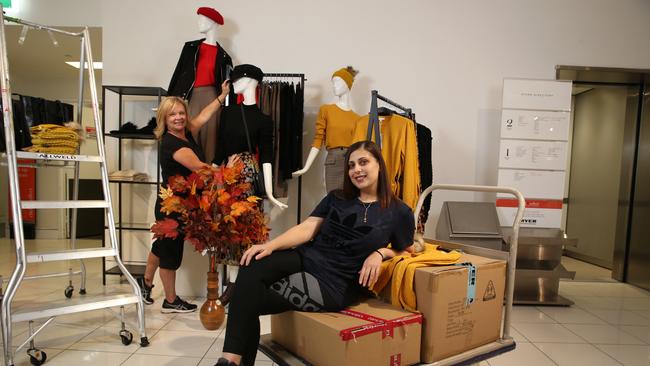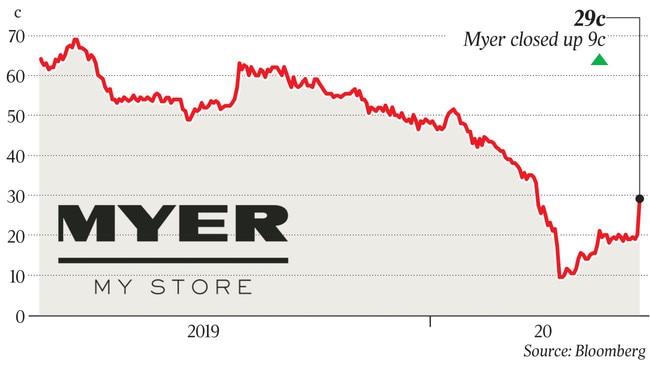Stores reopen but the rules have changed
When Noni B, Katies and Millers begin to thaw from hibernation over the coming days, the changing rooms will remain firmly shut.

When Noni B, Katies and Millers begin to thaw from hibernation over the coming days and weeks to once again invite shoppers into their stores, the changing rooms will remain firmly shut, with a wrongly directed cough or sneeze potentially spreading the coronavirus.
“We have got to make sure that safety is paramount and we have done a lot of hard work on that to make sure we are not putting anyone at risk,’’ Mosaic Brands chief executive Scott Evans told The Weekend Australian as his company’s 1400 stores, including Noni B, Katies, Millers and Autograph prepare for reopening.
“We even are keeping the fitting rooms closed and we are not allowing customers into the fitting rooms.
“The reason we are not doing that is someone coughs or sneezes in their, it is an enclosed space.
“You can’t try on clothes, you can buy it, take it home and obviously if it’s not right you can bring it back — we have a very good returns policy.

“And so that is a big impact, because obviously a lot of our sales come from the fitting room, because that is where the customers are relaxed and can see what it looks like.’’ At Myer in Bankstown in Sydney’s west, similar health and safety procedures are going through their final paces.
Shop assistants are restocking the shelves and making the window displays as welcoming as possible as the nation’s biggest department store begins a rolling reopening across Australia.
Myer has also opened several stores in Brisbane in time for Mothers Day.
But the Myer stores that are reopening will look slightly different; sneeze guards will be in place at cash registers, while suit, shoe and intimate apparel fittings will remain suspended, as will the use of change rooms.
“Our priority continues to be the health and wellbeing of our customers and team members, and to assist and support governments in limiting the spread of COVID-19,’’ a Myer spokesman said.
“In line with the easing of restrictions in Queensland, we look forward to trialling the opening of five Queensland stores, providing our customers with great brands at great value, in a safe shopping environment.”
It is the much the same for the rest of Australia’s $320bn retail sector, the country’s second largest employer — a ‘new normal’ way of conducting business that is to protect staff and customers alike as they come into contact for the first time in months.
This weekend will mark a huge milestone in the unwinding of social distancing and home isolation regulations as retailers get the confidence — and government backing — to begin reopening their stores.
More will open on Monday and even more next week and into June, with the health of the national economy resting on the confidence of consumers to spend money and shops being able to open.
The move follows Prime Minister Scott Morrison on Friday mapping out a three-stage plan created by the national cabinet to bring the economy out of hibernation by July, which will include an easing of home isolation and more non-essential trips to the shops.
Retail stocks — led by Myer — went on a bullish sprint.
But it will be a new way of shopping, a new way of interacting with customers in the physical confines of a small shop, with hand sanitisers, limits on the number of shoppers in a store and closed changing rooms.
But will retail be able to survive and generate profits with one arm tied behind its back and shops running at half or even a quarter of their capacity?
And how will shoppers react to those rules?
For the fashion industry it is going to be a tough ask for women to buy clothing without even trying it on.
“In terms of the economics of the store, we did a trial last week and the learnings were pretty solid,” said Mosaic’s Scott Evans.
“The footfall out there is increasing week on week. I don’t think that necessarily means the spending habit will increase week on week, and I mean that specific to us.”
Dominique Lamb, chief executive of the National Retail Association, said it was “absolutely crucial” that we saw retail reopenings with a leading pack of retailers sending a positive signal to the rest of the market.
“It is a really good sign that some of these major brands are taking that plunge and taking the choice to reopen in certain locations across the country,’’ Ms Lamb told The Weekend Australian.
But the slow reawakening of the retail sector will mean nothing if the shoppers don’t turn up.
“I think that for many retailers obviously the crucial component here is foot traffic and being able to attract as many consumers back to those (shopping) centres as possible, and an important thing to be able to do that is not only having stores open but having consumers and workers feeling safe to in those centres or in those strip shops,” she said.
“And from that perspective we have seen a huge investment from retailers to ensure that they can keep their consumers and workers safe, and that they are adhering to those hygiene protocols.’’
Where goes retail might well go the nation. The behemoth $320bn sector is the country’s second-largest pool of jobs and has been utterly devastated by the lockdowns.
Only a two months ago the biggest concern of retailers was getting shipments of supplies from China as that country imposed its own quarantine and city lockdowns in January; now it’s a vastly different and more scary story of retailers struggling to survive.
The Australian Bureau of Statistics estimates that between March 14 and April 18 the retail sector lost almost 7 per cent of its jobs. The retail sector employs around 1.25 million people.
Deloitte Access Economics says in a recent report that there is a mixture of large positives and large negatives for the retail sector from the coronavirus crisis.
“Indeed this sector has a wider dispersion of outcomes than almost any other sector. On the one hand, supermarkets are operating at more than full capacity and can be expected to remain so for the foreseeable future. On the other hand, shopping malls have been nearly, foot traffic is a fraction of what it was, discretionary spending has been ravaged, and a range of retailers have shut their doors.”
While Deloitte Access Economics said the hit to retail turnover has been a multiple of the downturn seen in the recession of the early 1990s, thankfully retail sector growth is expected to pick up from 2021-22 onwards.
“I think our customers will be cautious,’’ Mr Evans said as Mosaic Brands tests the water for a staggered reopening, “we certainly don't think that normality returns in four weeks time, not at all, maybe it is a year or two at least.’’




To join the conversation, please log in. Don't have an account? Register
Join the conversation, you are commenting as Logout